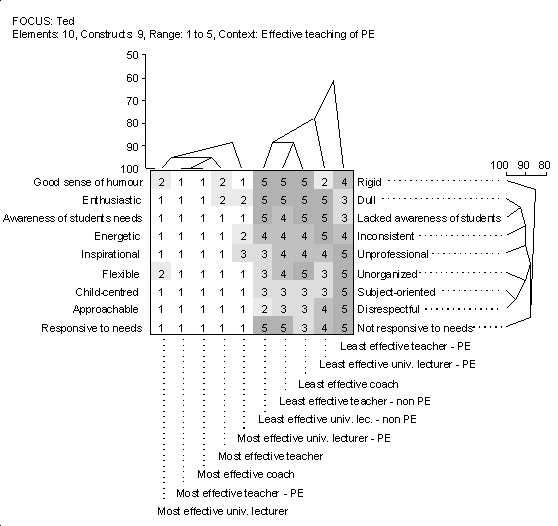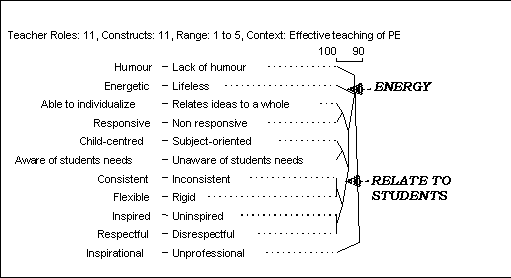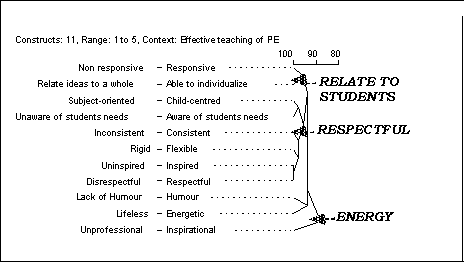
The purpose of the study was to interpret how pre-service teachers reflectively evolve their personal beliefs and values about teaching after their initial experience of teaching in schools. The following question was addressed: given the findings of a study of pre-service teachers' personal constructs for teaching, how does one pre-service teacher (Ted) articulate his sense of becoming a teacher? In other words, how did Ted learn, and know he had learned, how to teach? The answer provided insights into how 'thinking like a teacher' evolved for one pre-service teacher.
METHOD FOR PERSONAL MEANING MAKING
A repertory grid analysis from George Kelly's (1955) personal construct psychology was employed to research pre-service teachers' beliefs about teaching. Personal construct psychology (PCP) is a procedure used in psycho-therapy. It offers a way of becoming aware of the biography that structures and guides a person's subjective judgments about a certain reality. PCP has been widely used in teacher education as a means of accessing pre-service teachers implicit beliefs about teaching (Diamond, 1991; Pope & Keen, 1981). As part of PCP, Kelly proposed a theory called constructive alternativism. This theory states that reality is subject to many alternative constructions. Kelly's PCP allows a person to probe the multiple meanings people can have of the same phenomenon.
This study probed the meaning of effective teaching in physical education. The repertory grid from PCP was used to explore "new" meaning about teaching. As shown in Figure 1, the grid creates a basic number pattern of ordinal ratings of elements on dichotomous constructs. The elements come from a pool of elements that are familiar to the participant. The elements used were related to teacher roles that had been experienced by all the pre-service teachers during their school days and during their experiences at the university. The constructs are bipolar descriptors, produced by participants from comparisons of elements representing different teachers. To produce this repertory grid, a one to five rating scale was used to rate each of the elements on each of the bi-polar constructs.
RESEARCH DESIGN AND DATA COLLECTION
Data for the repertory grids was collected at the beginning of a teacher preparation course in PE. Initially, the course ran for six weeks. For the six weeks the methodology of the course concentrated on inquiry-oriented conceptual approaches. In the course, emphasis was made to responding to the play of learners and developing learner autonomy. This was done through demonstration lessons from the course instructor and by encouraging the pre-service teachers to attempt similar approaches in peer teaching experiences. After this six weeks the pre-service teachers took a four-week field experience in the schools, they then returned to the university for three weeks to complete course requirements. During the final three weeks the pre-service teachers engaged in a second learning conversation and re-rated their initial repertory grids. The new repertory grids included an element representing the pre-service teacher. The main purpose of this learning conversation was to explore how the pre-service teachers' beliefs and values about effective teachers had changed as a result of their teaching experiences.

Figure 1: Tedís initial repertory grid
All conversations were transcribed. Data transcripts averaged to about 10,000 words. This data was summarized for each pre-service teacher in personal case studies which ranged from 3,000 to 6,000 words. A year later, a further interview with the author about the pre-service teachers possible special thoughts and concerns about their case studies resulted in "interview three" of the study. The transcripts from these interviews ranged from 2,000-3,000 words in length. Several of the pre-service teachers met with the author on an informal basis during the subsequent academic year to share teaching experiences that they felt revealed their articulated beliefs and values about effective teaching.
DATA ANALYSIS
The computer program GRIDTHINK was used to analyze the repertory grids. This program provides a two-way cluster analysis that re-orders the rows of constructs and the columns of elements to produce a grid in with the least variation between adjacent constructs and elements. The relationships between elements and constructs is visualized as tree diagrams showing clusters that indicate the closest relationship between number patterns (see Figure 1). Analysis of the conversation about relationships between elements and constructs produced certain themes that the student teachers referred to as a reference for the effectiveness of teachers. These themes were defined as "thought objects" for teaching.
A conversation about the repertory grid generates a commonsense meaning rather than a technical meaning. This type of commonsense meaning that is developed in conversation between two people is generally constructed with metaphor. The metaphorical content of teachers speech has promise for discerning the implicit ways in which teachers construct their professional world and the imagery they use to construct their world of teaching.
Conversations between the pre-service teachers and the author involved a sharing of stories on teaching that supported beliefs about effective teaching. The pre-service-teachers' stories about their teaching practice became self-affirming and representative of educational values being transformed into practice.
FINDINGS
The participant, Ted, was in his final year of a four-year, combined honors degree in French and Physical Education. He was in his late twenties and had extensive experience playing and coaching ice hockey, karate and football. The first interview focused on Ted's initial repertory grid (see Figure 2). During the interview, it was established that the clusters of the b-polar constructs associated to the themes of Relate to students and generating Energy in the class. These themes were labeled as the "thought objects" of Ted's reflexive thinking about teaching.

Figure 2: A summary of Tedís bi-polar constructs in his repertory grid.
Ted conducted his practicum an inner city junior-high school. The children in the school came from middle to low income families. Ted felt the school created a system that focused teachers toward subject-centered, controlling practices; it did not support dealing with children in a child-centered, more personal and individual way.
After the practicum, Ted re-rated his selected teachers on his initial bi-polar constructs. The new grid indicated that his perceptions of his past teachers had changed. The new clustering of Tedís bi-polar constructs based on his re-rating of his past teachers is shown in Figure 3. As can be seen, Ted maintained the original "thought objects" of Energy and Relate to students, but now he also focused upon the need for a teacher to be Respectful. This new "thought object" is generated from a new clustering in the re-rated grid and is connected to the Relate to students idea. Its importance to Ted is highlighted in the following story from his field experience.
Tedís class on practicum included a large pupil, Michael, notorious as the cityís under fifteen wrestling champion. Michael was often suspended from the school for being overly aggressive.

Figure 3: New clustering of Tedís bi-polar constructs in his repertory grid
On his initial encounter with Michael, Ted shared enthusiastically the joys of playing football, a sport that Ted knew Michael had started to play. As Ted said,
Michael replied, "Yah. O.K. Mr. F., no problem."
When Cody started fooling around again Michael slammed his big fist on the table grunting, "No!"
The story illustrated how Ted was finding support in his experiences for his beliefs in the importance of Relating to students and being Respectful of students. Ted felt this story was in contrast to the advice he was given by his co-operating teacher who told him to "be tough, then loosen up." According to Ted, the difficulty about teaching was being consistent and sincere in how he believed an effective teacher should be.
An analysis of Ted's use of metaphor in his first interview revealed a physical, in contact, mobile sense of teaching which was probably connected to his six years of experience teaching karate, coaching hockey, and playing hockey as a child. When describing effective teachers, Ted made many references to teaching as a process where you had to "push," "pull" and "proceed forward." According to him, these effective teachers were "moving" work along. Ted also made many references to energy: "full of energy"; "full of life and energy"; and "pump your self up." According to Ted, this display of energy was "natural" and "contagious." Metaphorically, Ted seemed to imply that energy could be caught like a virus. For Ted humor was a vital component in teaching that energizes students. In this sense, Ted seemed to consider humor as being infectious. However, as it turned out this metaphor of energy generated from humor did not work for Ted when he taught in a school.
After the practicum Ted's physical metaphor to understand teaching had developed with words such as "reaching," "crushed" and "squeezing." Ted's comments about his field experience school were that lessons tended to be activities that the students were just exposed to and told "to learn or else." A common response from kids was to fight harshness or to at least feel resentment." Ted felt himself rising to a level of strictness that the pupils expected. As he described, "harsher...I mean like sharp," not like "I was use to being as a coach." As Ted said, "I was fighting not to put my ideas on the back burner."
Ted description of his teaching included the comments, "I was full of emotions...full of energy." Metaphorically, he seemed to feel that "kids feed off your energy." This idea of students "feeding" off a teacher's energy places Ted at the center, as the source of energy. However, in a negative sense, feeding off Ted's energy can create an image of a teacher being drained of energy. In Ted's words, "The kids were just feeding off it...When I went home I was exhausted."
After the practicum, Ted had a 'new' metaphor for teaching focused on teacher as researcher. He felt he was "researching" how to teach and that he "did little experiments" because according to him, "there are things I wanted to discover." The physical metaphor that had initially been apart of Ted's understanding was still present. However, Ted's hockey coaching had changed to incorporate the "researching" metaphor. Ted found himself asking his players to explore "what would happen if..."
A year later, in Ted's third interview, his sense of teaching as possible research seemed to be a fundamental part of knowing the act of teaching. Words such as "extract," "synthesize," "focus" and "connect" framed Ted's notion of teaching. According to him the key to effective teaching is, "learn from it, think about researching it and doing it... writing it down, talking about it."
Ted's "thought objects" can be illustrated with an example in a story. During the his final practicum, Ted's commitment to his "thought objects" resulted in him concentrating on being enthusiastic, energetic and also respectful to students. A story from Ted's teaching experience highlights these beliefs. Ted gave the following account:
CONCLUSION
One participant's beliefs were articulated in "thought objects" through the conversations based on a repertory grid. For this participant these "thought objects" were gradually realized in practice. The participant's metaphorical language used to describe teaching evolved as he attempted to express the reality of teaching that allowed him to transform his "thought objects" into practice. The data from this study, and the results from other pre-service teachers, are suggestive of the potential this process has for the examination of teachers' personal thinking on teaching to support them realizing their beliefs about effective teaching. As Diamond (1991) has observed, the repertory grid process creates a catalyst for teachers who are able "to compose their own narratives...chart their way through their present and towards their future stages of development as teachers" p. 41).
REFERENCES
Diamond, C. (1991). Teacher Education as Transformation. Milton Keynes, Philadelphia: Open University Press.
Hopper, T. F. (1996). Subjective Knowing, Personal Construct Psychology and Teacher Education: Teaching to Learn in Physical Education. Unpublished Dissertation, University of Alberta.
Kelly, G. (1955). The Psychology of Personal Constructs Vol. I. New York: W. W. Norton & Co., Inc.
Pope, M., & Keen, T. (1981). Personal Construct Psychology and Education. London: Academic Press.